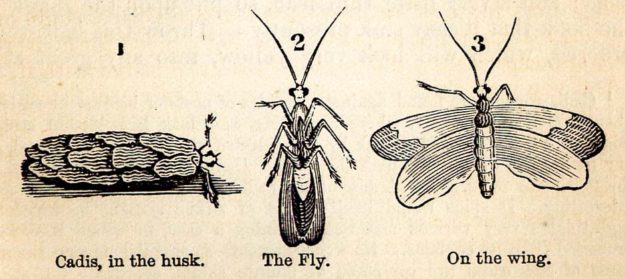Isaak Walton & Charles Cotton, The complete Angler of the contemplative man’s recreation: being a discourse on rivers, fish-onds, fish and fishing, Londres, George Bell, (1653), 1900.
You are also to know, that there be divers kinds of cadis or case-worms, that are to be found in this nation in several district counties, and in several little brook that relate to biggers rivers: as namely one cadis called a Piper, whose husk or case is a piece of reed about an inch long, or longer, and as big about as the compass of a two-pence. (1)These worms being kept three or four days in a woollen bag with sand at the bottom of it, and the bag wet once a day, will in three or four days turn to be yellow ; and these be a choice bait for the chub or chavender, or indeed for any great fish, for it is a large bait. There is also a lesser cadis-worm, called a Cockspur, being in fashion like the spur of a cock, sharp at one end, and the case or house in which this dwells is made of small husks, and gravel, and slime, most curiously made of these, even so as to be wondered at; but not to be made by man, no more than a king-fisher’s nest (2) can, which is made of little fishe’s bones, and have such a geometrical interweaving and connection, as the like is not to be done by the art of man. This kind of cadis is a choice bait for any float-fish; it is much less than the piper-cadis, and to be so redered; and these many be so preserved ten, fifteen, or twenty, days, or it may be longer. There is also another cadis, called by some a Straw-worm and by some a Ruff-coat: whose house or case is made of little pieces of bents, and rushes, and straws, and water-weeds, and I know not what; which are so knit together with condensed slime, that they stick about her husk or case not unlike the bristles of a hedgehog. These three cadises are commonly taken in the beginning of summer; and are good, indeed, to take any kind of fish, with float or otherwise (3) I might tell you of many more, which as these do early, so those have their time also of turning to be flies later in summer; but I might lose myself and tire you by such a discourse: I shall therefore, but remember you, that to know these and their several kinds, and to what flies every particular cadis turn, and then how to use them, first as they be cadis, and after as they be flies, is an art, and an art that every one that professes to be an angler has not leisure to search over; and, if he had, is not capable of learning. I’ll tell you, Scholar, several countries have several kinds of cadises, that indeed differ as much as dogs do: that is to say, as much as a very cur and a greyhound to. These be usually bred in the very little rills or ditches that run into biger rivers than any other. I know not, or of what, this cadis receives life, or what coloured fly it turns to; but, doubtless, they are the death of many Trouts : and this is one killing way. Notes: (1) The half-groat of sterling silver, coined for the last time in the currency of Charles I. (2) Walton here mistake for a kingfisher’s nest, the round crustaceaou shell of the sea urchin (Echinus). The kingfisher does not appear to make any nest, except the flooring of fish bones derived from his prey.- Rennie. (3) Caddis-worms are found against the sides of poster or boards, or rushes, about a foot under water, where they cling, and look like bits of rotten sticks or reeds. They lie thick by the sides of shallows, on the sand, in any little creeks or ditches nigh the river. Use a cleft stick as directed in the text.- Browne. The habits of the cadis-worm are very curious and interesting. It spins round itself a sort of silken sheath, to which it agglutinates very various materials, forming a case, in which it is well protected from its enemies. No worm presents so singular an appearance. Some of the cases are composed of minute shalls, especially the small water-snail; some of fragments of wood, straw or twigs; some of aquatic and vegetable refuse. The piper-cadis, or straw-worm, encases itself within two pieces of reed or rush, from which it protudes its head and feet, and thus crawl along the bottom of the water. Figures of the various sorts of cadis will be found in Westwood’s « Classification of Insects », 2 vols. 8vo. –Ed. (p.284-286.)

Now both these flies, and, I Believe, many others, though I think not all, are certainly and demonstratively bred in the very rivers where they are taken: our Cadis or Codbait, which lie under stones in the bottom of the water, most of them turning into those two flies, and bein gathered in the husk, or crust, near the time of their maturity are very easily know and distinguished; (p.416).